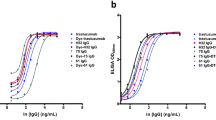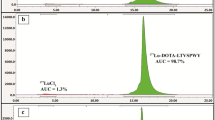Abstract
A native form of mouse monoclonal IgG1 antibody called MAG-1, which recognizes an epitope on provasopressin, has been found to shrink and produce extensive necrosis of human breast tumor xenografts in nu/nu mice. We examined the ability of 90Yttrium-labeled and native MAG-1 to affect the growth in nu/nu mice of cancer xenografts that were estrogen-responsive (from MCF-7 cells) and triple-negative (from MDA-MB231 cells). The growth rates of treated cells were compared to those receiving saline vehicle and those receiving 90Yttrium-labeled and native forms of the ubiquitous antibody, MOPC21. Short-term treatments (4 doses over 6 days) not only with 90Yttrium-MAG-1 but also native MAG-1 produced large reductions in size of rapidly growing tumors of both types, while both 90Yttrium- MOPC21 and native MOPC21 had no effect. Native and 90Yttrium-MAG-1 effects were similar, and arrested tumors recommenced growing soon after treatments stopped. Increasing native MAG-1 treatment to single dosing for 16 consecutive days shrank tumors of both types with no regrowth apparent over a 20-day post-treatment period of observation. Pathological examination of such tumors revealed they had undergone very extensive (>66%) necrosis.






Similar content being viewed by others
References
American Cancer Society (2008) Cancer facts and figures. American Cancer Society, Atlanta
Jordon VC (2006) Tamoxifen (ICI46, 474) as a targeted therapy to treat and prevent breast cancer. Br J Pharmcol 147:S269–S276
Brueggemeier RW, Hackett JC, Diaz-Cruz ES (2005) Aromatase inhibitors in the treatment of breast cancer. Endocr Rev 26:331–345
De Giorgi U, Rosti G, Frassineti L, Kopf B, Giovanni N, Zumaglini F, Marangolo M (2007) High-dose chemotherapy for triple negative breast cancer. Ann Oncol 18:202–203
Rodenhuis S, Bontenbal M, van Hoesel QGCM et al (2006) Efficacy of high-dose alkylating chemotherapy in HER2/neu-negative breast cancer. Ann Oncol 17:588–596
North WG, Wells W, Fay MJ, Mathew RS, Donnelly EM, Memoli VA (2003) Immunohistochemical evaluation of vasopressin expression in breast fibrocystic disease and ductal carcinoma in situ (DCIS). Endocr Pathol 14:257–262
Taylor AH, Ang VTY, Jenkins JS, Silverlight JJ, Coombes RC, Lauqmani YA (1990) Interaction of vasopressin and oxytocin with human breast cancer cells. Cancer Res 50:7882–7886
North WG, Fay MJ, Du J (1999) MCF-7 breast cancer cells express normal forms of all vasopressin receptors plus an abnormal V2R. Peptides 20:837–842
North WG (2000) Gene regulation of vasopressin and vasopressin receptors in cancer. Exp Physiol 85S:27–40
North WG, Hirsh V, Lisbona R, Schulz J, Cooper B (1989) Imaging of small cell carcinoma using 131I-labelled antibodies to vasopressin associated human neurophysin (VP-HNP). Nucl Med Commun 10:643–651
Keegan BP, Memoli VA, North WG (2002) Targeting the neurophysin-related cell surface antigen on small cell lung cancer using a monoclonal antibody against the glycopeptide region (MAG-1) of provasopressin. Mol Cancer Ther 1:1153–1159
Keegan BP, Akerman BL, Pequeux C, North WG (2006) Provasopressin expression by breast cancer cells: implications for growth and novel treatment strategies. Breast Cancer Res Treat 95:265–277
North WG, Memoli VA, Keegan BP (2005) Immunohistochemical recognition of NRSA on small cell lung cancer with a monoclonal antibody (MAG-1) that recognizes the carboxyl terminus of provasopressin. Appl Immunohistochem Mol Morphol 13:363–366
US Patent Application:# 10/521,091. Inventors: William G. North, Brendan Keegan, Lyn Oligino. Title: Compositions and Uses Thereof For identifying and Targeting Provasopressin-expressing Cancer Cells. Filed: 10/11/2005
Schubert D (1968) Immunoglobulin assembly in a mouse myeloma. Proc Natl Acad Sci USA 60:683–690
Adams GP, Shaller CC, Dadachova E, Simmons HH, Horak EM, Tesfaye A, Klein-Szanto AJ, Marks JD, Brechbiel MW, Weiner LM (2004) A single treatment of yttrium-90-labeled CHX-A″-C6.5 diabody inhibits the growth of established human tumor xenografts in immunodeficient mice. Cancer Res 64:6200–6206
Valabrega G, Montemurro F, Aglietta M (2007) Trastuzumab: mechanism of action, resistance and future perspectives in Her2-overexpressing breast cancer. Ann Oncol 18:977–984
Stein R, Chen S, Goldenberg DM (1997) Advantage of Yttrium-90-labeled over iodine-131-labeled monoclonal antibodies in the treatment of a human lung carcinoma xenograft. Cancer 80:2636–2641
Keegan BP, Memoli VA, Wells WA, North WG (2010) Detection of provasopressin in invasive and non-invasive (DCIS) human breast cancer using a monoclonal antibody directed against the C-terminus (MAG-1). Breast Cancer: Basic and Clin Res 4:15–22
Hudis CA (2007) Trastuzumab-mechanism of action and use. N Engl J Med 357:1664–1666
Acknowledgment
This study was supported in part by USPHS SBIR Phase I Grant: 1R43CA119483-01 to Woomera Therapeutic Inc.
Conflict of interest statement
Concerning the signed COI, all authors with the exception of William G. North and Roy H.L. Pang have no commercial interest relating to the material in the manuscript. However, as explained in the referenced patent applicant and by institute designation, Drs. North and Pang do have a commercial interest in Woomera Therapeutics Inc., the patent applicant. Dr. North is a full-time faculty member of Dartmouth Medical School, but is also the President of Woomera Therapeutics Inc. and holds >40% interest in that company. Dr. Pang is the CEO and CSO of the company.
Author information
Authors and Affiliations
Corresponding author
Rights and permissions
About this article
Cite this article
North, W.G., Pang, R.H.L., Gao, G. et al. Native MAG-1 antibody almost destroys human breast cancer xenografts. Breast Cancer Res Treat 127, 631–637 (2011). https://doi.org/10.1007/s10549-010-1009-6
Received:
Accepted:
Published:
Issue Date:
DOI: https://doi.org/10.1007/s10549-010-1009-6




